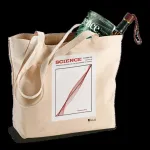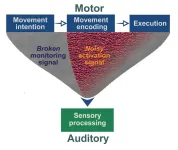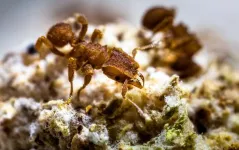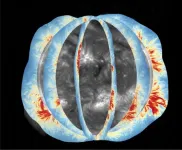(Press-News.org) Since the 2020 murder by Minneapolis police of George Floyd brought nationwide calls for change amid concerns that prevailing practices were not grounded in evidence and created harm, policing has been in turmoil. Implementation science (IS) involves integrating effective and evidence-based innovations into routine practice in fields like health care. Yet despite its potential, IS—and specifically, evidence-based policing (EBP)—remain vastly understudied and unused in police settings. In a new article, researchers provide an orientation to these issues to help practitioners and researchers involved with policing integrate IS into EBP.
The article was written by researchers at Temple University, Brown University, the University of Massachusetts, RTI International, Rhode Island Hospital, and George Mason University. It is published in Police Quarterly.
“Policing is ripe for new methods to examine how to change organizations and how to assess the adoption, implementation, and sustainability of evidence-driven reforms in police settings,” says Brandon del Pozo, assistant professor of medicine and of health services, policy and practice at Brown University’s Warren Alpert Medical School, as well as a research scientist at Rhode Island Hospital, who led the study.
In this article, researchers offer agendas for integrating IS into EBP as police seek to adopt evidence-informed practices that deliver public safety, respect rights, and boost community satisfaction and trust. IS promotes the use of metrics to assess how different police practices influence various outcomes, which provides police leadership valuable data about their organization.
In the article, researchers describe the historical roots of EBP in an evidence-based approach to health care, demonstrate the commonalities that make IS as natural to policing as to medicine, and survey research on IS in policing. In addition, they adapt a conceptual model of IS to policing, present two IS frameworks available to researchers and practitioners of EBP, and introduce three types of hybrid implementation/effectiveness trials suitable for use in dynamic police settings, as well as case studies.
The article also highlights the importance of the effective de-implementation of substandard or problematic practices as a key aspect of IS and discusses how police practice that fully embraces evidence will be guided by contestable values and norms, with IS providing a way to reconcile this concern. The authors conclude with a research and practice agenda for integrating IS into EBP as police contend with calls to adopt evidence-informed practices, and they address counterinfluences in policing that hamper IS’s effectiveness.
“Evidence-based policing, which aims to identify and adopt police practices supported by scientific evidence, is frequently discussed in policing but has been slow to catch on in the United States,” explains Steven Belenko, professor of criminal justice at Temple University, who coauthored the study. Belenko is an expert whose work is promoted by the NCJA Crime and Justice Research Alliance, which is funded by the National Criminal Justice Association.
“De-escalation, procedural justice, hot spot policing, focused deterrence, and virtually any other body of evidence-based practices lend themselves to studying the constructs that ensure they can be implemented with enough fidelity to be effective and sustainable.”
The study was supported by the National Institute on Drug Abuse.
END
New article provides orientation to using implementation science in policing
Evidence-based policing can help ensure practices are rooted in research
2024-10-03
ELSE PRESS RELEASES FROM THIS DATE:
Three beer-related discoveries to celebrate Oktoberfest
2024-10-03
Frothy or smooth, bitter or sweet, light or dark: There’s a beer for most palates. As people around the world pour over the best brews at Oktoberfest celebrations or ferment about their favorite fall-themed beers, three papers published in ACS journals crack open new insights into these beverages. And if you’re hop-ing to conduct studies to find which beer is good for what ales you, please drink responsibly. Reporters can request free access to these papers by emailing newsroom@acs.org.
Coriander’s origin changes beer flavor. Just like simmering a stew, brewing a beer with herbs and spices can enhance its flavor. A study in ACS Food Science ...
AAAS launches user research project to inform the new AAAS.org
2024-10-03
Washington, D.C. — The American Association for the Advancement of Science, one of the world’s largest general scientific societies and publisher of the Science family of journals, announces an external research project to help the organization reimagine AAAS.org as part of a website overhaul project, which recently kicked off. AAAS is seeking input from its key audiences, including reporters and public information officers, to better align the experience and content of the website. As AAAS embarks on the next ...
In odd galaxy, NASA's Webb finds potential missing link to first stars
2024-10-03
Looking deep into the early universe with NASA’s James Webb Space Telescope, astronomers have found something unprecedented: a galaxy with an odd light signature, which they attribute to its gas outshining its stars. Found approximately one billion years after the big bang, galaxy GS-NDG-9422 (9422) may be a missing-link phase of galactic evolution between the universe’s first stars and familiar, well-established galaxies.
“My first thought in looking at the galaxy’s spectrum was, ‘that’s weird,’ which is ...
Adding beans and pulses can lead to improved shortfall nutrient intakes and a higher diet quality in American adults
2024-10-03
Moscow, Idaho, October 3, 2024: New research showing the association between greater bean and pulse consumption and improved shortfall nutrient intakes and a higher diet quality in American adults will be presented during the Academy of Nutrition and Dietetics (the Academy) Food & Nutrition Conference & Expo (FNCE) 2024 in Minneapolis, MN. The poster session is scheduled for Tuesday, October 8, 2024, from 10:45 – 11:45 AM CT at the Minneapolis Convention Center.
Researchers assessed the effect of increased bean and pulse consumption, in the typical US dietary pattern, on shortfall ...
What happens in the brain when a person with schizophrenia “hears voices”?
2024-10-03
Auditory hallucinations are likely the result of abnormalities in two brain processes: a “broken” corollary discharge that fails to suppress self-generated sounds, and a “noisy” efference copy that makes the brain hear these sounds more intensely than it should. That is the conclusion of a new study published October 3rd in the open-access journal PLOS Biology by Xing Tian, of New York University Shanghai, China, and colleagues.
Patients with certain mental disorders, including schizophrenia, often hear voices in the absence of sound. Patients may fail to distinguish between their ...
Ant agriculture began 66 million years ago in the aftermath of the asteroid that doomed the dinosaurs
2024-10-03
When humans began farming crops thousands of years ago, agriculture had already been around for millions of years. In fact, several animal lineages have been growing their own food since long before humans evolved as a species.
According to a new study, colonies of ants began farming fungi when an asteroid struck Earth 66 million years ago. This impact caused a global mass extinction but also created ideal conditions for fungi to thrive. Innovative ants began cultivating the fungi, creating an evolutionary partnership that became even more tightly intertwined 27 million years ago and continues to this day.
In a paper published today, Oct. 3, in the journal Science, scientists at the Smithsonian’s ...
A new era of solar observation
2024-10-03
EMBARGOED: Not for Release Until 2:00 pm U.S. Eastern Time Thursday, 3 October 2024.
A new era of solar observation
International team produces global maps of coronal magnetic field
Contacts:
Audrey Merket, NSF NCAR and UCAR Science Writer and Public Information Officer
amerket@ucar.edu
303-497-8293
David Hosansky, NSF NCAR and UCAR Manager of Media Relations
hosansky@ucar.edu
720-470-2073
For the first time, scientists have taken near-daily measurements of the Sun’s global coronal magnetic field, a region of the Sun that has only been observed irregularly in the past. The resulting observations ...
The true global impact of species-loss caused by humans is far greater than expected – new study reveals
2024-10-03
The extinction of hundreds of bird species caused by humans over the last 130,000 years has has led to substantial reductions in avian functional diversity – a measure of the range of different roles and functions that birds undertake within the environment –
and resulted in the loss of approximately 3 billion years of unique evolutionary history, according to a new study published today in Science.
Whilst humans have been driving a global erosion of species richness for millennia, the consequences of past extinctions for other dimensions of biodiversity are poorly known. ...
Smartphone-assisted “scavenger hunt” identifies people at risk for dementia
2024-10-03
Researchers from DZNE and Otto von Guericke University Magdeburg have identified individuals with increased risk for dementia using mobility data, recorded during a smartphone-based wayfinding task on the university campus. The findings, reported in the journal PLOS Digital Health, show the potential of smartphone data, collected in conditions close to everyday life, for the early detection and monitoring of Alzheimer’s disease. The study included 72 adults; about a third of them with subjective cognitive decline (SCD), a condition that is a known risk factor for dementia.
Alzheimer’s disease usually develops unnoticed over years and eventually ...
Green subsidies may have hidden costs, experts warn
2024-10-03
Government subsidies for business practices and processes should be approached with caution, even when they seem to be environmentally friendly, writes a group of scientists and economists in this week’s Policy Forum in the journal Science.
They argue that subsidies can alter market pressures, leading to unintended consequences that not only perpetuate harmful subsidies over time but also diminish the overall effectiveness of those intended to promote environmental sustainability.
Therefore, when they must be used, subsidies should have clear end-dates, advise the authors.
“We’ve got this odd juxtaposition of ...
LAST 30 PRESS RELEASES:
Pre-school health programme does not improve children’s diet or physical activity, prompting call for policy changes, study finds
Autumn clock change linked to reduction in certain health conditions
AI images of doctors can exaggerate and reinforce existing stereotypes
Where medicine meets melody – how lullabies help babies and parents in intensive care
We may never be able to tell if AI becomes conscious, argues philosopher
AI video translation shows promise but humans still hold the edge
Deep ocean earthquakes drive Southern Ocean’s massive phytoplankton blooms, study finds
Without campus leftovers to pick through, the beaks of this bird changed shape during the pandemic
High-dose antibiotic does not reduce mortality in tuberculous meningitis
How many insects fly in the sky above the USA?
Could cheese protect your brain health?
Who faces more difficulty recovering from stroke?
Colliding galaxies create the brightest, fastest growing black holes at their center
New BrainHealth research reveals tradeoffs on sleep with cannabis use for chronic pain
Aging-US now on ResearchGate, enhancing visibility for authors and readers
'Molecular glue' stabilizes protein that inhibits development of non-small cell lung cancer
Mount Sinai Health System is recognized in 2025 Chime Digital Health Most Wired survey
From prey to predator: How carnivores spread beneficial fungi
Menopause symptoms may be frequent and have negative effects, according to female endurance athletes
US Congressmembers’ responses on X to mass shooting events differ along party lines
KAIST-UEL team develops “origami” airless wheel to explore lunar caves
Individual genetic differences render some therapies ineffective
Engineering dendritic cells boosts cancer immunotherapy
Sophisticated neuroimaging reveals PTSD in WTC responders is linked to measurable physical changes in brain structure
Health policy experts identify promising strategies for providing health care to homeless people
Study explores role of neutrophils in canine atopic dermatitis
Mayo Clinic researchers develop AI-ECG model to diagnose liver disease earlier
Heavy menstruation common among teenage girls – questionnaire reveals risk of iron deficiency
New study explores why open water swimming feels so powerful for midlife women
In echo of Jurassic Park, mosquitoes capture entire ecosystems in their blood meals
[Press-News.org] New article provides orientation to using implementation science in policingEvidence-based policing can help ensure practices are rooted in research






